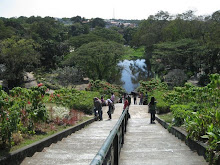Tuesday, July 03, 2012
ILOILO | Miag-ao Church
The Miag-ao Church was built in 1786 by Spanish Augustinian missionaries and was declared as part of the UNESCO World Heritage Site "Baroque Churches of the Philippines" in 1993. On the front facade, which is flanked by two watchtower belfries, one can see the unique blending of Spanish and native influences.
The central feature of the bas-relief facade is a large coconut tree which reaches almost to the apex. While an integral part of the Philippine landscape, the coconut tree is also the subject of lore. According to an old Philippine legend, the coconut tree was the only bequest from a loving mother to her two children, a tree which sustained them for life. On the church's facade the coconut tree appears as the "tree of life" to which St. Christopher carrying the Child Jesus on his shoulder is clinging to. The lesser facades feature the daily life of Miagaowanons during the time. Also depicted are other native flora and fauna, as well as native dress.
The church and its watchtowers were also built to defend the town and its people against raids by the Moros. It therefore has thick walls and, reportedly, secret passages. Indeed stretching along the Iloilo coast are defensive towers, but none that equal the size of the Miag-ao. It is because of this defensive purpose that it is sometimes referred to as the Miag-ao Fortress Church.
Source: Wikipedia
ILOILO | Molo Church
Molo is one of the seven districts of Iloilo City. It was built by Spaniards and was formerly called the Parian (Chinatown) due to its large number of Chinese residents and their business establishments in the area at the time. Its name was later changed to Moro during the frequent arrival of Muslim pirates from Mindanao until it later evolved into Molo. Molo was a town before it was absorbed by Iloilo City during its charter in 1937.
The Gothic Renaissance Church of Molo was used as a watch tower to warn the people if there are any attackers on the shore of Iloilo City. It is a fine coral stone church with Classical and Gothic details. It is also known as the feminist church because of the beautiful female saints lining inside the church.
Sometime during 1896, the site was visited by Jose Rizal, mainly to look at the Biblically inspired artwork (no longer present). It was also used as a haven for civilians during the Second World War; testament to the effects of the war are the bullet holes still present in some of its bells.
The first thing that will strike the visitor to the Molo Church are the imposing spires, which are a bright red in color. As impressive as the exterior, the interior is even more stunning. The trained eye will see that the artistry is a magnificent amalgamation of the Gothic and Romanesque architectural styles. To the casual viewer, it is an awesome view, wherein the various shades of yellow, gold and shades of brown combine to create a resplendent area for prayer and devotion.
A tour of the Molo Church will reveal the glorious altars, fashioned in the Gothic manner, and adorned by elaborate works of art. Also prominently displayed are 16 images of female saintly figures including Saint Anne, the patroness to whom the shrine is dedicated.
The views of the Molo Church are compelling at any time of the day, but it is during the afternoon that the full beauty of the magnificent structure is unveiled. Standing outside the church you can see the soft glow of the rays of the sun as they cast down on the façade. The results are unique and fascinating displays of light and shade.
Source: Wikipedia and http://www.iloiloboard.com/molo-church.php
ILOILO | jaro cathedral
The National Shrine of Our Lady of the Candles informally known as Jaro Cathedral is the cathedral seat for the Roman Catholic Archbishop of Jaro. It is located in district of Jaro in Iloilo City, in the province of Iloilo, on the island of Panay, in the Western Visayas region of the Philippines. It is known as the shrine of Our Lady of the Candles under the original patronage of Saint Elizabeth of Hungary.
The church is the famous Parish of Our Lady of Candles, also known as the Jaro Metropolitan Cathedral, the headquarters of the Archdiocese of Jaro and the site of a miraculous statue of the Virgin Mary, which was canonically crowned by the late Pope John Paul II during his visit in 1982. The image is the only religious icon in the country to have been personally crowned by a Pope.
Jaro Belfry, ruined in a 1948 earthquake, but now restored. One of the few belfries in the country that stands apart from the church.
The bell tower unusually is located across a busy street on the Jaro Plaza. Such construction arrangement is rare in the Philippines. Usually the Churches and their belfries are built adjacent to each other, or at least they are located on the same plot of land. This is a remnant of an older building that collapsed during an earthquake. The original cathedral was built in 1874 by the first bishop of Jaro, Mariano Cuartero, O.P. It was destroyed by an earthquake in January 1948 and later repaired in 1956 by the first Archbishop of Jaro, Jose Maria Cuenco.
Source: http://en.wikipedia.org/wiki/Jaro_Cathedral
Subscribe to:
Posts (Atom)





































